 |
||
|
||
| ||
Today we have in our lab a 5.1 acoustic system which competes against such famous products as Creative DTT3500 and its updated version Inspire 5700 in quality and price. The tested sample is a top model in the multimedia line of TEAC. What makes this system interesting is a huge wooden subwoofer, an integrated DD5.1 decoder and a remote control. The PowerMax 2000 is an excellent combination of the classical design and a comfortable operation.
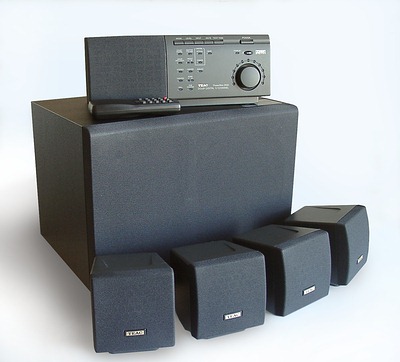 The satellites are 5 x 15 W RMS in power and the subwoofer is 45 W RMS. Frequency range is 140 Hz - 20 kHz for the satellites and 50 - 250 Hz for the subwoofer. AccessoriesThe acoustic system ships in a blue box which displays this system on all its sides. The box is relatively small because the speakers are not large and they are placed compactly inside. The box has two cut-outs so that it will be comfortable for you to carry it. What's inside the box:
The user manual contains in-depth description of the system and connection ways in 6 languages. SpeakersThe front and rear speakers are identical, they measure 95x105x105 mm, i.e. they are just a bit bigger than the satellites of the DTT3500 and they don't need much space on your desktop. The speakers stand on two rubber legs mounted at the front. They have the "sealed box" acoustic scheme. Their cabinets are made of 3mm plastic. As the protective grills can't be taken off, we are not able to show you the dynamic loudspeaker.
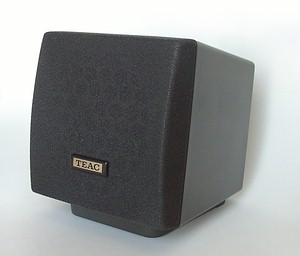 The satellite has batting inside which completely eliminates all additional plastic sounds. The dynamic loudspeaker is magnetically shielded, its impedance is 8 Ohm. The loudspeaker's cone is 7.6 cm in diameter. The cables are connected to the back panel of the satellites with the help of string clamps. DecoderThe central speaker is combined with the decoder. It is connected to the subwoofer with an 11-conductor cable. The ferrite ring is used to eliminate noise and pickups.
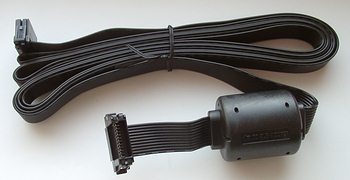 Unfortunately, the central speaker has the same dynamic loudspeaker as in all other speakers. As you know, for 5.1 sound it's necessary to have a normal central channel so that dialogs can be reproduced on a high-quality level. Otherwise, they become lost amidst all other sounds. The decoder measures 278x96x136 mm; and it stands
firmly on its 4 rubber legs on the top of the monitor.
 The front panel contains the following buttons:
Under each button are several LEDs (they are shown in parentheses above). The volume of the chosen parameter is adjusted with a discrete regulator which indicates volume levels (in the right lower corner on the photo). The decoder's part uses a DD-decoder's CS4923 05-CL chip and a 6-channel CS4226 KQ DAC from Cirrus Logic. By the way, the same DAC contained an external DD/DTS Jazz Speakers DE-005 decoder. 20-bit converters of this DAC impressed us much that time. At least, they sound pleasantly, and outdo converters of multimedia sound cards based on the Sigmatel codecs when coupled with high-quality wooden speakers. Usage of such high-quality DACs makes me feel sorry that a multichannel digital-in is lacking. That is why when the Live!/Live!5.1/Audigy is connected in a digital mode, at best a Dolby ProLogic can be used. Of course, with the nForce a normal 5.1 sound will be provided not only in DVD movies, but I don't think that mainboards on the 420-D are widespread. Remote controlAll the functions above can be controlled with a remote control. Here you can adjust volume of an arbitrary chosen channel, while in the decoder you can switch channels only in a definite order.
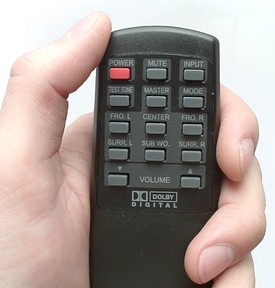 SubwooferThe subwoofer's cabinet is made of resin-bonded clipboard (not of cardboard like in the SVEN speakers). The wooden panels are 1cm thick. I must say that the most modern subwoofers have at least 1.5 cm panels. Thick panels lessen sounds produced by the cabinet when lows are played. The sub is not large - 348x250x278 mm, and it stands on 4 plastic 4cm legs. The subwoofer has a phase-inverter acoustic scheme. It is in fact a LF speaker, which allows for high-quality reproduction of the whole LF range. The LF speaker's cone is made of paper and output onto the front panel. The corrugation is made of soft rubber and is 16 cm in diameter. The impedance of the LF speaker's cone is 4 Ohm. The cone is protected with a grill which is made in the form of a frame with acoustic material.
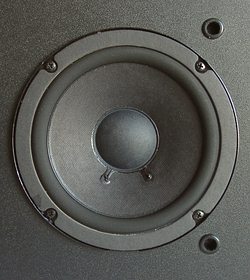 Two phase-inverters' tubes of a small diameter are output onto the rear panel. They are made of plastic and cast together with the rear panel of plastic.
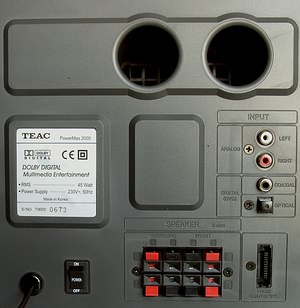 Here's what you can find on the rear panel:
Below you can see insides of the amplifying unit. On the top are heatsink fins of the amplification chips, on the left are 2 transformers and on the right there are printed-circuit boards and phase-inverter tubes. A LF speaker is placed above the transformer.
 The power unit houses 4 impressive smoothening capacitors of 3300 mF each, that is why there is no ground noise in the speakers caused by alternating current. On the right side of the board is a decoder and a 6-channel DAC. Main amplification chips are seated on the rear side. Amplification sectionThe manufacturer uses 4 impressive amplification chips from ST which are pressed against the heatsink covered with thermo grease by a metallic strap.
 The TDA7295 chip is used to amplify a LF signal coming to the subwoofer. Look how the THD depends on power (the graph is taken from the chips' specification).
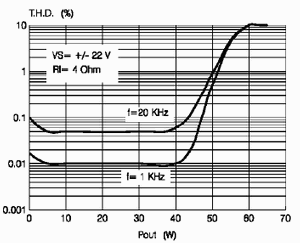 Dependence of THD on power for the TDA7295 chip The power is really striking when the THD is low. We measured the voltage on outputs of this chip and it was +/-29 V. It means that the graph will shift to the right, and specified 45 W can be considered even understated. You don't see often such power reserve in the multimedia acoustics! The two other chips are used to amplify a signal applied to the rear and front satellites. They are dual-channel amplifiers marked as TDA7265. Look how distortions depend on power:
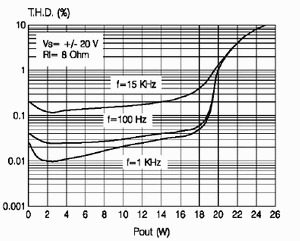 Dependence of THD on power for the TDA7265 chip The power values are also good when the THD level is low. Taking into account that the voltage we measured is +/-22V the graphs represent the facts. The Abit SP-60 which we tasted lately had just 10 W at best, and here we have twice higher power for each channel! At last, here is the TDA7261 chip which is meant for amplification of the central channel.
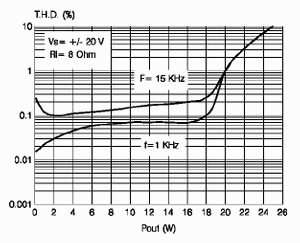 Dependence of THD on power for the TDA7261 chip The voltage is +/-22 V. The graphs show that the amplification part of the PowerMax 2000 incorporates quite good chips. Quite often I witness that multimedia systems do not have optimal amplification solutions: power is too low and amplifiers are overloaded when the volume level is 90%-100%. A company loses much if it doesn't pay careful attention to this issue. Remember that some audio-system makers stake primarily on design. ConnectionThe cables are long enough: 3 m for the front and 9 m for the rear satellites. The special 11-conductor cable meant for the central speaker is 3.5 m. The insulant (for front and rear) is rather firm and is 2 mm thick together with a wire. When we connected the Live!5.1 in a digital mode there were no problems in operation of the decoder. There were no compatibility problems in a digital mode with Creative cards either (which took place in case of the Jazz products based on the similar receiver-decoder chip). The system excellently played both CD and MP3 and DVD movies. Subjective testsThe sound from the speakers was estimated when the digital signal was taken from the Live! 5.1 and WaveTerminal2496 sound cards. The latter was used to eliminate an effect produced by mixing and resampling algorithms of the Creative card, and first of all, to lessen the cut-off at high frequencies. However, the difference between the cards isn't noticeable. We tried 44.1 and 48 kHz files. 24/96 reproduction is not supported by this system. A few words on correct placement of the satellites and subwoofer. The experiments show that for a small room front satellites and a user should form an equilateral triangle with the sides of 1 m. So that the high-frequency efficiency can be higher the speakers should be turned a bit towards the user and placed not lower than 10-15 cm relative to the speaker's ears (as the loudspeaker's axis can be lifted it's not required that they are placed at the same level with his/her ears). The optimal place for the subwoofer is when LF speakers are directed directly at the user and placed under the table not closer than 20 cm to a wall. If the sub is placed at the side of the user the direction of sound makes a negative effect. Reproduction of the music made a pleasant impression on us. If a user is seated in the correct position the system creates a uniform and non-stressing filed around him/her. I didn't feel that the sound was discrete. If quality of a sound source is good (wav files grabbed from CD) no distortions can be noticeable. The stereo panorama is excellent. The frequency range sounds as a single whole, without a gap between the satellites and the subwoofer. The subwoofer produces no parasitic mid-range sounds up to the 50% of the volume level (at the FS level of the input signal); when the volume level is high the rear plastic panel and not very firm construction of the cabinet bring in parasitic sounds. However, a volume control is usually placed at 20..30%. The amplifier has a great volume reserve for cases when quiet sounds are reproduced. The satellites lack for transparency, and the subwoofer should be more aggressive. It takes quite much time to get used to the tone coloration. What the system can do best is to play modern music. But I hope nobody is going to use it to listen jazz or classical music. I'm also glad that my ears do not get tired even after too long listening. For the experiment we replaced one of the Teac2000 satellites with a speaker of the DTT3500 system. This is a direct competitor to the tested system, and the loudspeakers have almost the same dimensions. To find out the difference we muffled the left and then the right channel in the mixer. The quality levels were very similar. The DTT3500 sounded brighter but it had more distortions and didn't have dynamic reserve. AFC measurementThe measurements were carried out according to a single testing technique developed with the RMAA-AE 3.2 program.
 AFC of the front speakers of the PowerMax 2000 and Creative DTT3500 measured with the swept sine The form and flatness are similar to the DTT3500. The hump at 2-3 kHz is caused by the resonance, and at the high frequencies the line is jumping. The most interesting thing is that if you set in the Winamp's equalizer a curve inverse to the AFC of the speakers, the sound will be much better!
 AFC of the subwoofer of the PowerMax 2000 measured with the swept sine on the LF speaker's axis in the nearest zone The subwoofer plays with confidence from 50 to 200 Hz and a little worse from 40 to 250 Hz. At a high volume level as the sine changed from 20 to 40 Hz there were parasitic resonances from the thin panels of the cabinet and insides of the subwoofer. I suspect that a LF filter is either absent or of low efficiency. On the other hand, the work of the crossover is excellent. The LF speaker don't reproduce any parasitic medium. ConclusionThe Teac PowerMax 2000 system made a good impression on us. After a huge wooden acoustic set (e.g., IHOO) it doesn't strike with high-quality sound, but it sounds well and has an impressive volume reserve for its category (wooden subwoofer, integrated decoder and DAC, remote control). Highs
Lows
Write a comment below. No registration needed!
|
Platform · Video · Multimedia · Mobile · Other || About us & Privacy policy · Twitter · Facebook Copyright © Byrds Research & Publishing, Ltd., 1997–2011. All rights reserved. |